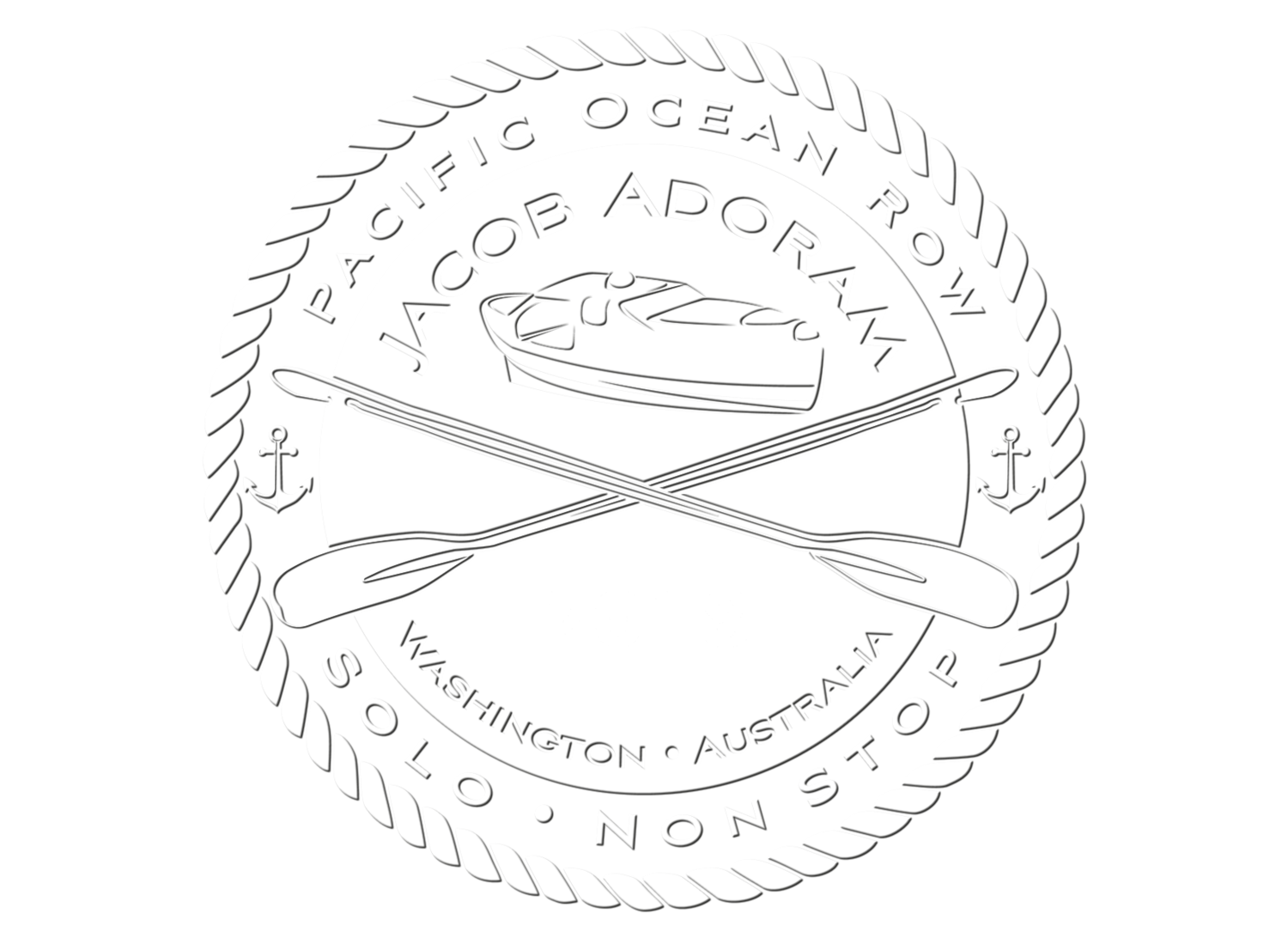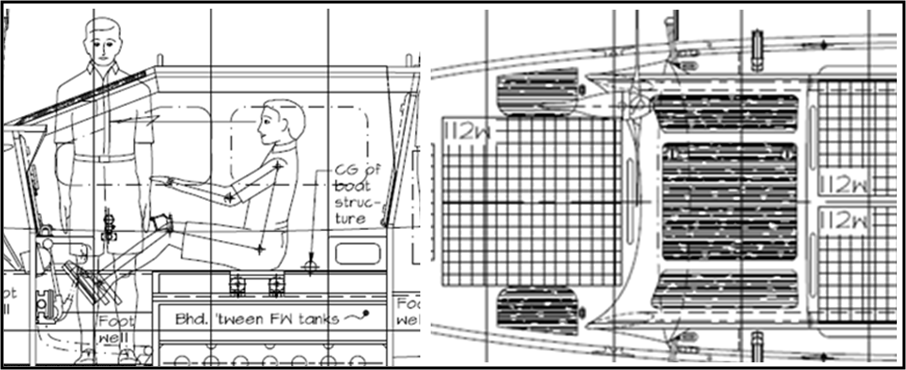The ocean rowing community apparently hates canvass protection over the rowing seat. The canvass material can presumably be used as a sail, which doesn't make much sense, considering every ocean rower carries some sort of sea anchor or drogue made from sail-like material. Smaller sea anchors are at least 6 feet in diameter, with far more material than that of a potential canvass roof. However, deciding on canvass protection can potentially have detrimental effects. I've been warned that the Ocean Rowing Society won't even recognize a row if there's a canvass covering. This type of extreme reaction isn't just with the Ocean Rowing Society, apparently negative reactions will permeate all throughout the ocean rowing community. I don't understand why. Please leave a comment if you have better insight.
I'm attempting to cross over 7,000 miles of open ocean in a one-man row boat. I'll be at sea for upwards of 10 months; I'm going to want some protection from the elements. My initial inclination was to just throw up a canvass covering when needed, which I obviously can't do without ruffling some feathers. So then came the design options; how do we design protection that is functional and generally accepted by fellow ocean rowers? I initially wanted to create a hardtop with removable panels, but logistically it didn't make much sense. So then came a permanent hardtop. I was initially weary of not having the same standing space, but Eric Sponberg (the designer) managed to come up with a brilliant solution. It'll still be a hardtop, but I'll also be able to stand vertically through a window hatch.
On the left, the figure is standing through the window hatch on the right between the solar panels. Click here for full pictures.
The hardtop provides the much needed protection, yet I can still stand when required, and it has the added bonus of providing more space for solar panels. Additionally, it also addresses some concerns in regard to design, mainly windage. The effect of wind upon the boat is a concern because some may see an unfair advantage if the forward cabin is significantly higher than the aft cabin. Obviously, if the front is taller, there's a big flat surface helping to push you along, provided you have a tailwind. I was also concerned from a sheer functionality perspective. If the boat is too tall, the wind will catch too much, and unless its pushing me in the right direction, I'll be working hard to keep a course. Rowers have failed exactly for this reason. I think Eric came up with a great solution for the task at hand, but that means having a slightly taller forward cabin, so we worked to try and achieve a design that quells most windage concerns.
The main issue here is the lack of published and generally accepted guidelines for designing an ocean rowing boat. Being a relatively new sport, there isn't an athletic commission, nor is there an adjudicating or sanctioning body for the overall sport of ocean rowing. The only guidance I have is from other boat designers, other ocean rowers, and the rules for specific ocean rowing events. New Ocean Wave is an organization that organizes "The Great Pacific Race" departing from San Francisco and ending in Hawaii. They specify general boat requirements for all participants, however, since I'm not participating, they don't technically apply to me.
After contacting the Ocean Rowing Society, I was informed that they recognize two classes of boats, the "Traditional" and "Open" class. The open class apparently accepts multihull designs, and others that don't fit the bill for a traditional boat. The details end there. So, in my effort to create a design that meets the ambiguous "Traditional" class, I compared my current hardtop design with the only rules I could find, that of New Ocean Wave, keeping in mind that my effort will be much longer and serve a different purpose.
Of note, within Rule 4.1.6: “There shall be no use, or attempted use, of any equipment that deliberately reduces rowing effort, or increases Boat speed.” This could potentially apply to a canvass top used as a sail, but since I no longer am planning a canvass top, I see nothing I'm violating here.
Rule 4.1.8: "The design of the Boat shall have 2 watertight Cabins, one at the bow and one at the stern. The rowing position shall be placed between the two cabins." Met.
Rule 4.1.9: “If the highest point on the bow Cabin is higher or an equal distance from the Load Waterline than the highest point on the stern Cabin, then the highest point of the bow Cabin shall be no higher than 48” (~1.2m) above the Load Waterline and the highest point of the stern Cabin shall be no lower than 27” (~0.7m) above the Load Waterline.” This is where I begin to deviate slightly. However, note the allowed difference in height, 48" for the front, 27" for the back, leaving the potential for a 21" height difference. My forward cabin is 54" above the Load Water Line (6" taller than allowed) and my aft cabin is 42", leaving a height difference of 12", much less than allowed in the New Ocean Wave races.
Yes, my boat is slightly taller than allowed for their race, but I'm also going over twice the distance. The important point being the windage advantage I have is less with a 12" gap than the allowed 21" gap. I'll note that my 12" difference doesn't not account for the bubble top I have planned over the main cabin. With the bubble top (equal windage from all directions), I'm at max height of 63.17", leaving a gap of 21.17". I'm essentially meeting the difference in cabin height requirement, even with the bubble top. Keep in mind the bubble top isn't built yet, so that last .17" could potentially be cut off.
Rule 4.1.10: “If the highest point on the stern Cabin is higher than the highest point on the bow Cabin, then the highest point of the stern Cabin shall be no higher than 56” (~1.4m) above the Load Waterline, and the highest point on the bow Cabin shall be no higher than 48” (~1.2m) above the Load Waterline.” This technically doesn't apply to my design since my bow cabin is higher. However, note the max cabin height of 56", which is 2" taller than my highest cabin (minus the bubble top).
Our last attempt to rule out a windage advantage is the design of the hardtop itself. The slope of the forward facing main cabin window is 24 degrees from horizontal. The aft facing hardtop window is 21 degrees from horizontal. My front window has 3 degrees of more windage potential than my aft window. This is based on angle alone; overall surface area at those angles should be considered to be exact. Since the aft facing window is slightly larger, I'm calling it a wash. Additionally, the hard top essentially renders the height difference in cabins a moot point. By connecting both cabins with a single, permanent structure, with nearly equal angles relative to horizontal, I don't see where I would have a wind advantage.
The last rule I want to mention is Rule 4.1.7: “The design of the Boat shall be restricted to ensure that it is fit for purpose, safe, and in the spirit of ocean rowing." We're doing everything we can to ensure the boat is safe and fit for purpose. We've also gone to great lengths ensuring my design is in the spirit of ocean rowing. In those efforts, I think we've come up with a design that meets every criteria I've encountered.
Thanks to New Ocean Wave for allowing me to share their rules. I hope this has been a sufficient explanation for the design decisions I've made in regard to the hardtop. If you have any questions, don't hesitate to ask!
Paddle On

